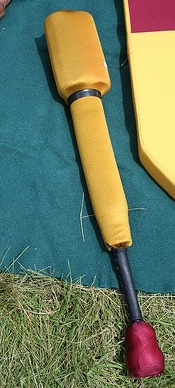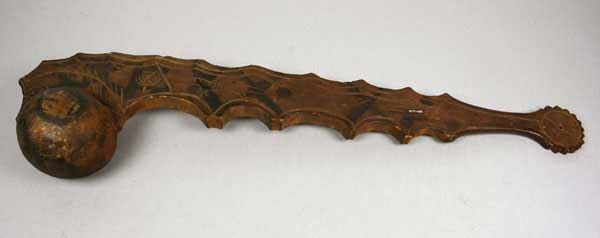Mace
About Maces

A mace is a simple weapon that uses a heavy head on the end of a handle to deliver powerful blows. A development of the club, a mace differs from a hammer in that the head of a mace is radially symmetric so that a blow can be delivered equally effectively with any side of the head. A mace consists of a strong, heavy wooden, metal-reinforced, or metal shaft, with a head made of stone, copper, bronze, iron or steel.
The head is normally about the same or slightly thicker than the diameter of the shaft and can be shaped with flanges, or knobs to allow greater penetration of armour. The length of maces can vary considerably. The maces of foot soldiers were usually quite short (two or three feet, or 700 to 900 mm). The maces of cavalrymen were longer and better designed for blows from horseback. Two-handed maces could be even larger. The flail is often, though incorrectly, referred to as a mace.
Maces are rarely used today for actual combat, but a large number of government bodies (for instance the U.S. Congress), universities and other institutions have ceremonial maces used as symbols of authority, in rituals and processions and for other purposes
Archaeological evidence suggests that maces were used extensively in prehistory. The mace was first developed around 12,000 BC and quickly became an important weapon. It was the first weapon developed specifically for killing humans. The first wooden maces, studded with flint or obsidian, became less popular due to the development of leather armour that could absorb the blows. Some maces had stone heads.
The discovery of copper and bronze made the first genuine metal maces possible. Many early cultures were unable to produce long, sharp and sturdy metal blades, which made the mace very popular. The Rajas, generals, and others that were high in command often had maces crafted of gold.
In the west, a beautifully-carved flint mace-head was one of the artifacts discovered in excavations of the Neolithic mound of Knowth in Ireland, and Bronze-age archaeology cites numerous finds of perforated mace-heads.
In ancient Egypt, stone mace heads were first used nearly 6,000 years ago in the predynastic period. The earliest known are disc maces with odd but beautifully formed stones mounted perpendicularly to their handle.
Maces as a weapon were used extensively in Egypt and neighboring Canaan. However, in regions where armor and helmets became commonly worn during combat, their use became limited.
The problem with early maces was that their stone heads shattered easily and it was difficult to fix the head to the wooden handle reliably. The Egyptians attempted to give them a disk shape in the predynastic period (about 3850-3650 BC) in order to increase their impact and even provide some cutting capabilities, but this seems to have been a short lived improvement.
A rounded pear form of mace head known as a "piriform" replaced the disc mace in the Naqada II period of pre-dynastic Upper Egypt (3600-3250 BC) and was used throughout the Naqada III period (3250-3100 BC). Similar mace heads were also used in Mesopotamia around 2450-1900 BC.
An important, later development in mace heads was the use of metal for their composition. With the advent of copper mace heads, they no longer shattered and a better fit could be made to the wooden club by giving the eye of the mace head the shape of a cone and using a tapered handle.
More than 1,500 years after the Scorpion King was depicted upon an Egyptian mace head, we find inscribed on a Stela of Amadeh the 18th Dynasty King, Amenhotep II, recording that: "His Majesty returned in joy of heart to his father Amun; his hand had struck down seven chiefs with his mace himself, which were in the territory of Takhsi"

The Shardanas or warriors from Sardinia who fought for Ramses II against the Hittities were armed with maces consisting of wooden sticks with bronze heads. Many bronze statuettes of the times show Sardinian warriors carrying swords, bows and original maces. The usage of maces in warfare is also described in the ancient Indian epics Ramayana and Mahabarata. Unique types of maces known as "Gadha" were used extensively in ancient Indian warfare.
The ancient Romans did not make wide use of maces, probably because of the influence of armour, and due to the nature of the Roman infantry fighting style which involved the pilum (or spear) and the gladius (short sword used in a stabbing fashion). The use of a heavy swinging-arc weapon in the well-disciplined tight formations of the Roman infantry would not have been practical. Persians used a variety of maces. One simple explanation is the mode of Persian warfare. Unlike Romans, Persians fielded large numbers of heavily armored and armed cavalry (see cataphracts). For a heavily armed Persian knight, a mace was as effective as a sword or battle axe. In fact, Shahnameh has countless references to heavily armored knights facing each other using mace, axe, or swords.
European Middle Ages
During the Middle Ages metal armour and chain mail protected against the blows of edged weapons and blocked arrows and other projectiles. Solid metal maces and war hammers proved able to inflict damage on well armoured knights, as the force of a blow from a mace is large enough to cause damage without penetrating the armour. One example of a mace capable of penetrating armor is the flanged mace. What makes a flanged mace different from other maces is the flanges, protruding edges of metal that allow it to dent or penetrate even the thickest armor. This variation of the mace did not become popular until significantly after knobbed maces. Although there are some references to flanged maces (bardoukion) as early as the Byzantine empire circa 900, (Ian Heath, "Armies of the Byzantine Empire 886-1118") it is commonly accepted that the flanged mace did not become popular in Europe until the 12th century. However, flanged mace heads were popular in the northern Muslim world even earlier, as some mace heads have been found even into ancient times.[citation needed]
Maces, being simple to make, cheap and straightforward in application, were quite common weapons. Peasant rebels and cheap conscript armies often had little more than maces, axes and pole arms. Few of these simple maces survive today. Most examples found in museums are of much better quality and often highly decorated. A mace type commonly used by the lower classes, called the Holy Water Sprinkler, was basically a wooden handle, with a wooden or metal head and radiating spikes; the name most likely originates from the similarity to the church object. Another - very ironic - name for a similar weapon is Goedendag, Dutch language for "good day!". A plançon a picot is a heavy and thick two-handed mace with an armour-piercing spike on top.
The mace was the usual weapon of the cavalieri, essentially mercenary armies of Northern Italy hired by Italian city-states and throughout Europe starting in the 14th Century. The production of both body armor and weaponry to support the cavalieri centered around Milan, partially in support of the Milanese movement to remain separate from Papal rule.
It is popularly believed that maces were employed by the clergy in warfare to avoid shedding blood (sine effusione sanguinis). The evidence for this is sparse and appears to derive almost entirely from the depiction of Bishop Odo of Bayeux wielding a club-like mace at the Battle of Hastings in the Bayeux Tapestry, the idea being either that he did so to avoid shedding blood or bearing the arms of war. The fact that his brother Duke William carries a similar item suggests that, in this context, the mace may have been simply a symbol of authority. Certainly, other Bishops were depicted bearing the arms of a knight without comment, such as Archbishop Turpin who bears both a spear and a sword named "Almace" in the The Song of Roland or Bishop Adhemar of Le Puy, who also appears to have fought as a knight during the First Crusade, an expedition that Odo joined and died during.
Much of the popularity of this view can be attributed to the Dungeons and Dragons game, which often limited its cleric class to bludgeoning weapons, at first influenced by the popular belief, and later on to reduce the class's power in battle, a rule that was widely imitated.

